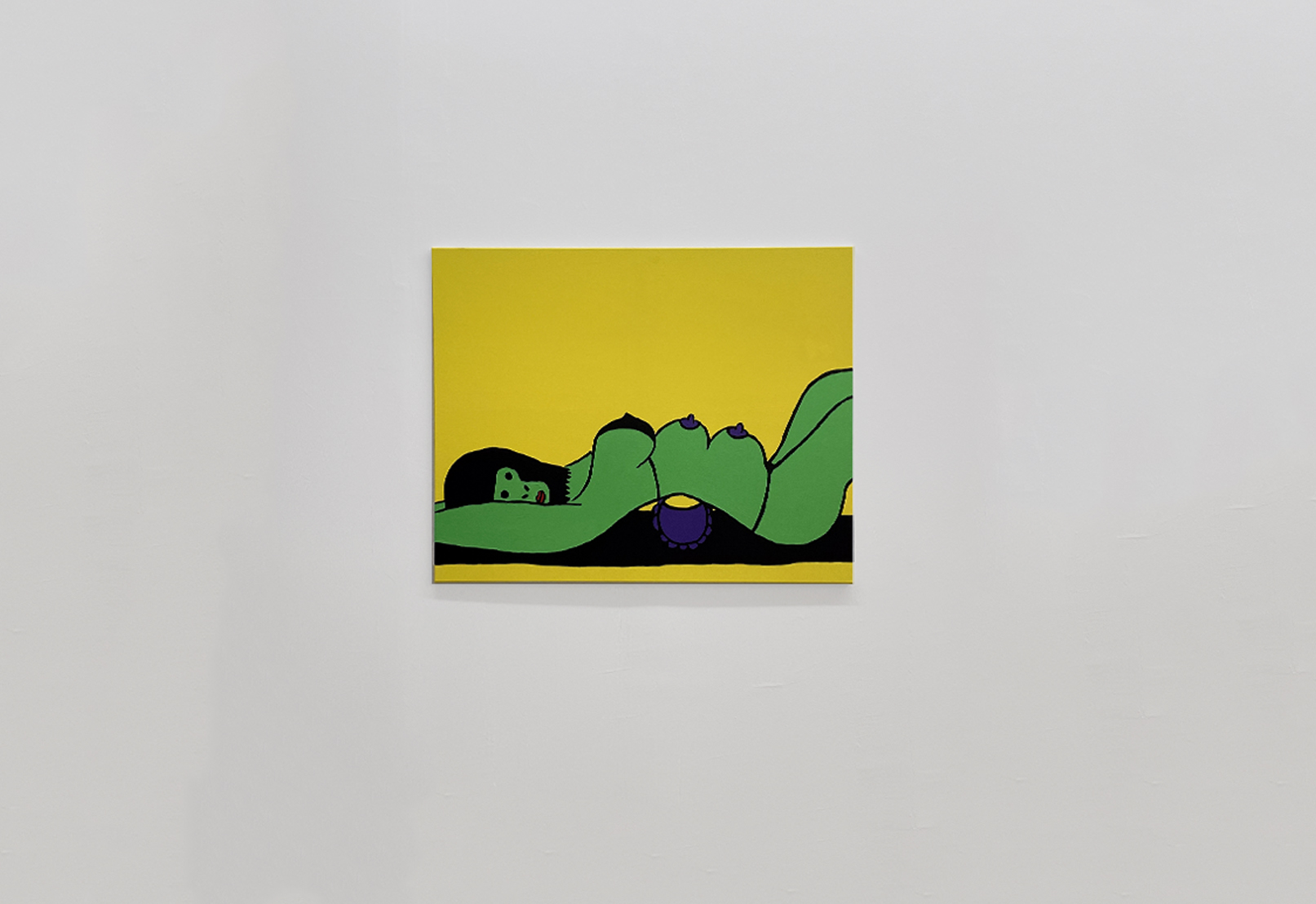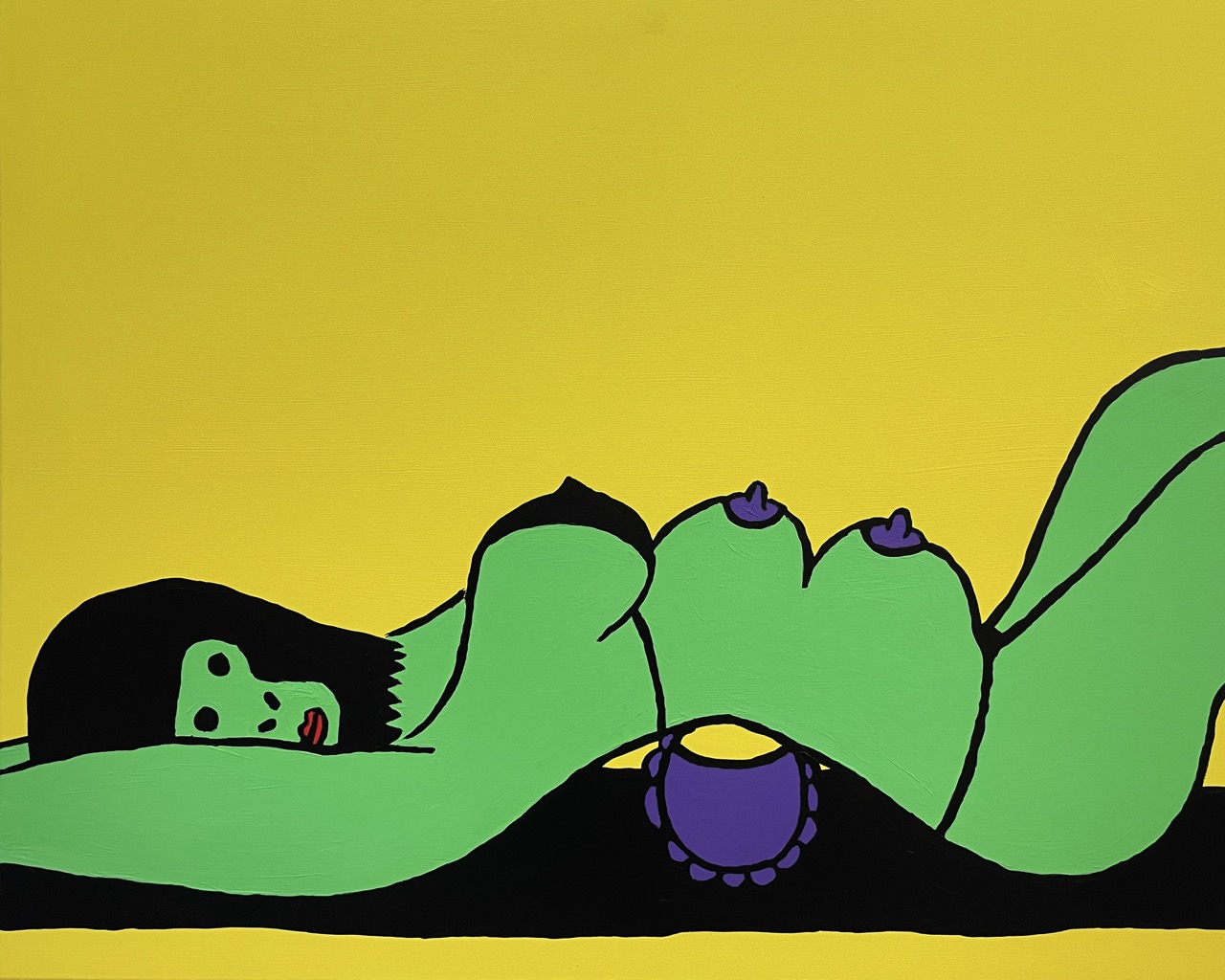Daniel Chluba: Kill the artist – Kill Daniel Chluba : Verena Kerfin Gallery, Köthener Strasse 28, Berlin 10963
Past
exhibition
Overview
The exhibition "Daniel Chluba: Kill the artist – Kill Daniel Chluba" at the BARK BERLIN Gallery presents a diverse collection of works that playfully interact with elements of pop culture and art history while simultaneously questioning the role of the artist.
Five large-format acrylic paintings on canvas dominate the space, characterized by simple, monochromatic color fields and black outlines reminiscent of coloring book aesthetics. One painting features a frontal depiction of a green gorilla head, evoking associations with primal force and wildness in art. Another piece portrays a reclining woman in a bikini with six breasts, exaggerating feminine representations and commenting on societal beauty ideals. The shark head brushing its visible teeth with a toothbrush adds a humorous element to the exhibition and could be interpreted as an ironic reference to consumerism and self-presentation. The recurring figure of the six-breasted woman, this time with a bird on her hand, connects mythological motifs with contemporary interpretation.
The clear linework and flat colors create a link to Pop Art, reminiscent of artists like Keith Haring who use simple forms to convey complex messages. The simplicity of the style contrasts with the depth of themes ranging from identity to self-perception.
Two paper sculptures expand the paintings into the three-dimensional realm. One depicts Daniel Chluba himself as a Playmobil-like figure, crafted from cardboard and painted red, reflecting the idea of the artist becoming part of his own work. This correlates with the exhibition title "Kill the artist – Kill Daniel Chluba", which possibly alludes to the artist's self-deconstruction. The second sculpture shows Chluba holding a purple shark, further extending the motifs of the paintings.
An interactive computer game invites visitors to immerse themselves directly into the artist's world. In this game, players control Chluba's cardboard figure, who, together with the shark, shoots at various objects like a gorilla, or vice versa. This element draws on the tradition of media art and connects it with current trends in gamification, further blurring the lines between artwork and viewer.
A central feature of the exhibition is the oversized letters forming the word "SAUGEIL". Each of the approximately two-meter-tall letters is made of cardboard, painted red, and covered with silver aluminum foil on the front and back. Suspended just above the floor from the ceiling and attached to disco ball motors, the letters rotate around their own axis. This kinetic installation plays with the viewer's perception and recalls experiments in kinetic art and Op Art, where movement and optical effects are paramount. Only when the letters align in a certain position does the word "SAUGEIL" (German slang for "extremely cool") become legible, serving as a humorous commentary on the art scene and its language.
These letters were also carried through the city in a performance. Daniel Chluba moved the installation in a caterpillar-like manner by continually bringing the last letter to the front. Through this continuous movement, he commented on the urban space and interacted with the environment. The performance plays with the dynamics of the city and echoes the practices of action art, where art in public spaces gains new meanings.
Daniel Chluba's exhibition raises questions about the role of the artist in modern society and plays with the idea of self-dissolution within one's own work. By combining painting, sculpture, digital media, and performance, he creates a multi-layered experience that invites the viewer to reflect on the relationship between artist, artwork, and audience.
Five large-format acrylic paintings on canvas dominate the space, characterized by simple, monochromatic color fields and black outlines reminiscent of coloring book aesthetics. One painting features a frontal depiction of a green gorilla head, evoking associations with primal force and wildness in art. Another piece portrays a reclining woman in a bikini with six breasts, exaggerating feminine representations and commenting on societal beauty ideals. The shark head brushing its visible teeth with a toothbrush adds a humorous element to the exhibition and could be interpreted as an ironic reference to consumerism and self-presentation. The recurring figure of the six-breasted woman, this time with a bird on her hand, connects mythological motifs with contemporary interpretation.
The clear linework and flat colors create a link to Pop Art, reminiscent of artists like Keith Haring who use simple forms to convey complex messages. The simplicity of the style contrasts with the depth of themes ranging from identity to self-perception.
Two paper sculptures expand the paintings into the three-dimensional realm. One depicts Daniel Chluba himself as a Playmobil-like figure, crafted from cardboard and painted red, reflecting the idea of the artist becoming part of his own work. This correlates with the exhibition title "Kill the artist – Kill Daniel Chluba", which possibly alludes to the artist's self-deconstruction. The second sculpture shows Chluba holding a purple shark, further extending the motifs of the paintings.
An interactive computer game invites visitors to immerse themselves directly into the artist's world. In this game, players control Chluba's cardboard figure, who, together with the shark, shoots at various objects like a gorilla, or vice versa. This element draws on the tradition of media art and connects it with current trends in gamification, further blurring the lines between artwork and viewer.
A central feature of the exhibition is the oversized letters forming the word "SAUGEIL". Each of the approximately two-meter-tall letters is made of cardboard, painted red, and covered with silver aluminum foil on the front and back. Suspended just above the floor from the ceiling and attached to disco ball motors, the letters rotate around their own axis. This kinetic installation plays with the viewer's perception and recalls experiments in kinetic art and Op Art, where movement and optical effects are paramount. Only when the letters align in a certain position does the word "SAUGEIL" (German slang for "extremely cool") become legible, serving as a humorous commentary on the art scene and its language.
These letters were also carried through the city in a performance. Daniel Chluba moved the installation in a caterpillar-like manner by continually bringing the last letter to the front. Through this continuous movement, he commented on the urban space and interacted with the environment. The performance plays with the dynamics of the city and echoes the practices of action art, where art in public spaces gains new meanings.
Daniel Chluba's exhibition raises questions about the role of the artist in modern society and plays with the idea of self-dissolution within one's own work. By combining painting, sculpture, digital media, and performance, he creates a multi-layered experience that invites the viewer to reflect on the relationship between artist, artwork, and audience.
Installation Views
Works






















